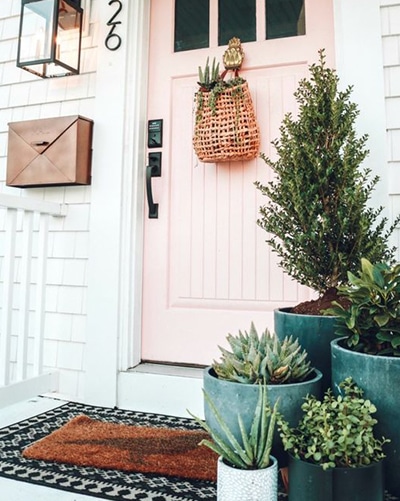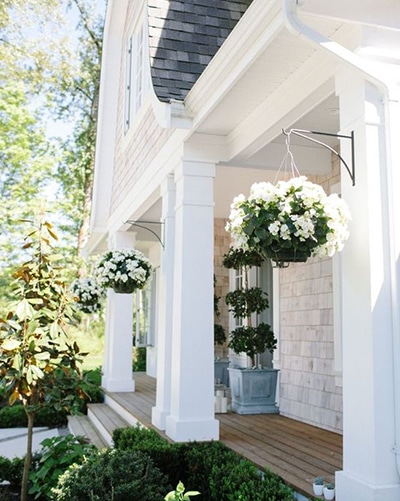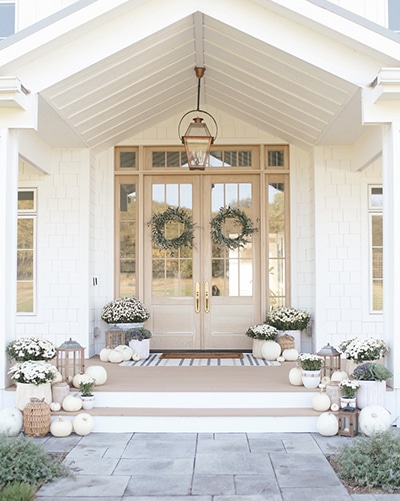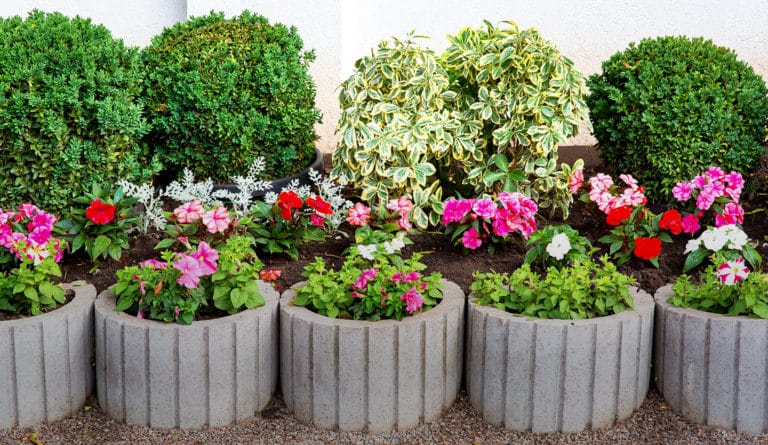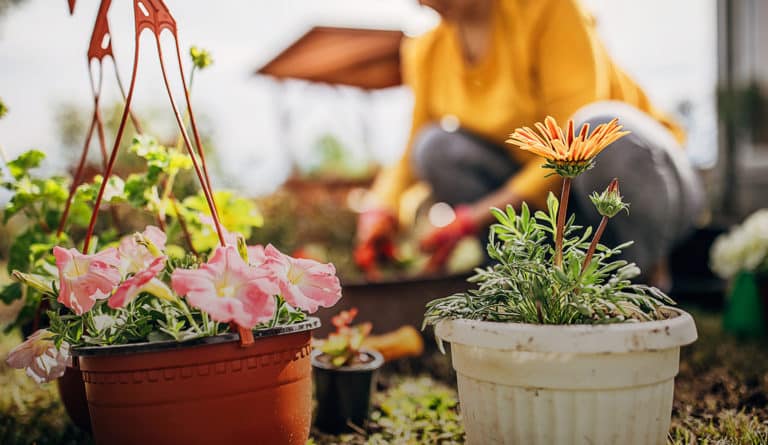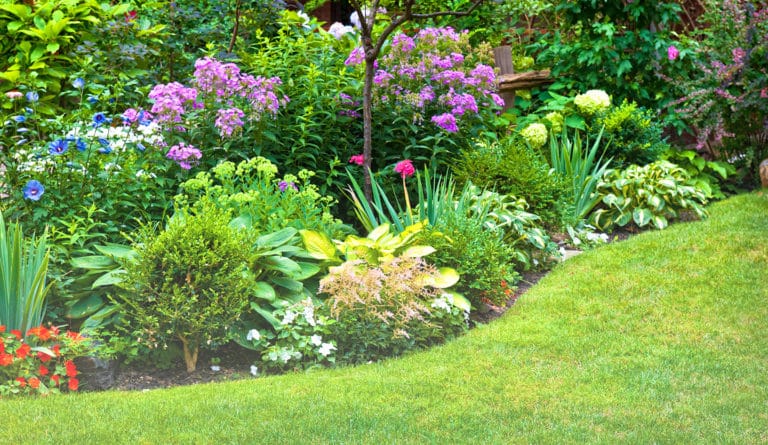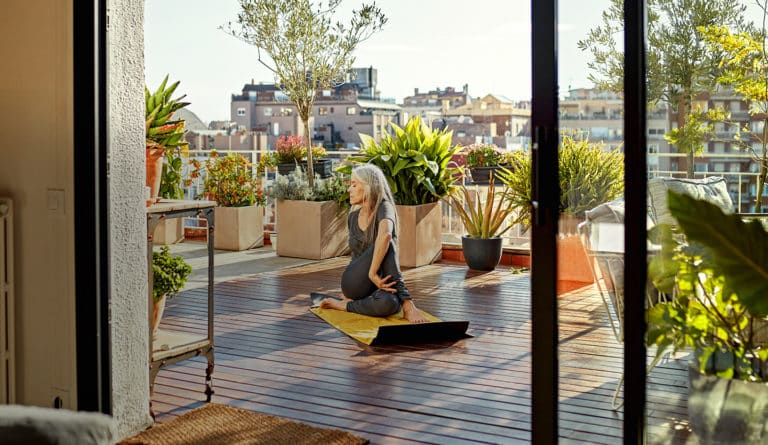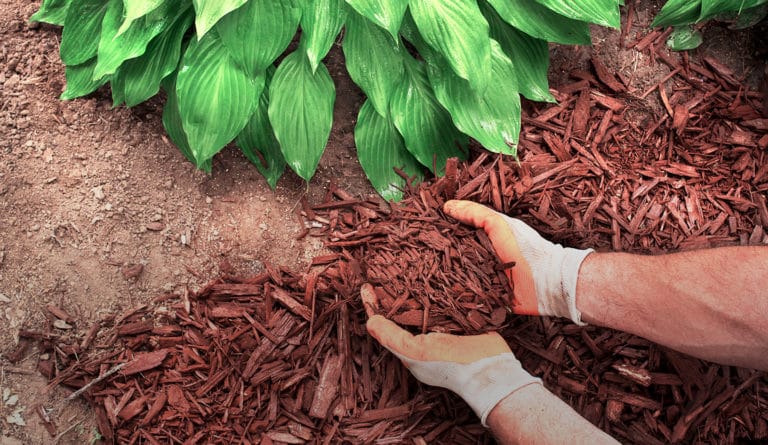As people we are genetically-programmed to spend time outside; however demands of our modern lives do not always make this possible. The tranquility of being surrounded by gardens shows to chemically reduce stress levels – simply spend time outdoors and you feel peace and calm. Keeping your mind focused and hands occupied with gardening puts you in a headspace that allows you to forget your worries. The act of planting is a hopeful one, as you grow new life, beautiful surroundings, and build a future from the soil.
GREEN LIVING
What better way to be welcomed home than with a plant-filled entranceway? Not only do greens create peace and serenity, they personalize your patio or porch entryway as a segue into your home.
In fact, more interior designers are paying attention to porches, extending the design of the home past the interior walls. Even rugs and tsoshkes are being brough out as design elements to porches.
how do you achieve this on-trend patio look? Here are 5 insider tips to get you started.
With some online research, leafing through home and garden magazines or visiting your local garden shop, you’ll have plenty of inspiration to make your patio pop with life. Whatever you choose, it’s great to have an entranceway that’s deserving of two green thumbs-up.
If you are a condo or apartment dweller who wishes for a backyard garden, we have good news. With some creativity and clever choices, you can transform your balcony into a verdant oasis.
Barren balcony walls can be spruced up with the right kind of plants. Due to limited balcony space, you’ll want to opt for greens, florals, vegetables and herbs that flourish in smaller pots. Here are our top tips for the best balcony plant choices and making the most of your limited space.
Top Tips for a Balcony Oasis
Assess Conditions
Determine what sunshine conditions your balcony gets. Many plants can get sunburnt in direct sunlight, while others wilt in shade, so research and choose accordingly.

Flourishing Florals
A surefire way to brighten a balcony is with colourful blooms. The trick is knowing which flowers thrive well in balcony pots. Begonias, petunias, and chrysanthemums are all hearty and attractive choices. Low-maintenance flowers, from the humble and beautiful columbine varietals to dramatic canna lilies in full bloom, are also great potted picks. If you have tropical indoor plants, move them outdoors in summer.

Make the most of vertical space
Source some suspended planters so you don’t consume too much precious balcony floor space. We have a separate section devoted to creating a vertical garden. Hang containers or shelving from your walls or get creative by repurposing ladders and pallets to layer your pots upwards. A trellis covered in climbing plants can also make a beautiful and attractive statement as well as offer privacy.

credit: www.instagram.com/egilfarstad 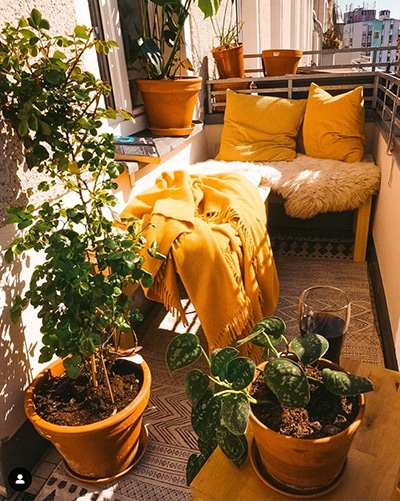
credit: www.instagram.com/fridlaa 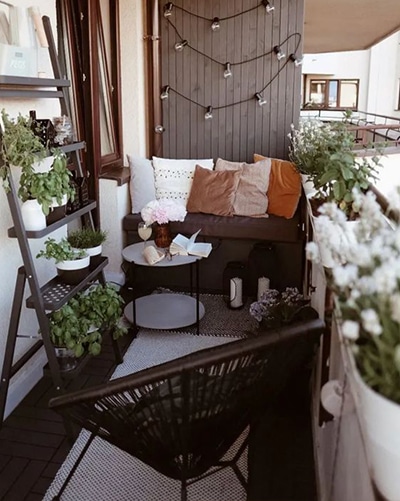
credit: www.instagram.com/jamjustyna
Both anecdotal and scientific evidence proves being outside in garden-fresh air has an enormously positive effect on our overall wellness. During the pandemic, being stuck at home impacted many people’s physical and mental health. Gardening saw a surge in popularity, with people who’d never picked up a spade getting outside to plant their own vegetable gardens and growing flowers.

Gardening & Body Chemistry
The sunshine vitamin, D, as well as the higher oxygen levels in green spaces also has many science-backed wellness benefits, including elevating self-esteem and mood and lowering stress and irritability. Getting outside gardening is an optimal way to get Vitamin D which synthesizes serotonin, our body’s happy chemical.
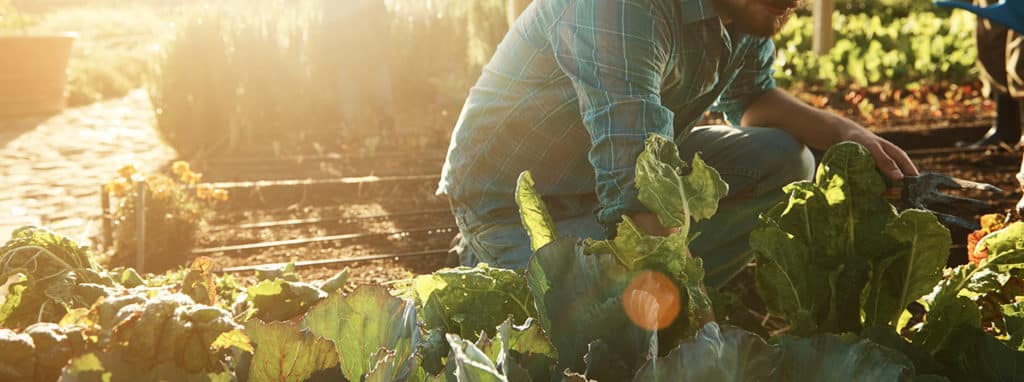
Healthy Diet
When homegrown garden vegetables and fruit are at your fingertips, it is easy to eat well. Apart from the endless wellness benefits of fresh food, pulled fresh from your garden saves more nutrients and the produce tastes better, too.

Green for Your Grey Matter
While stepping into sunshine and inhaling the fresh scent of cut grass makes us feel better immediately, what may not be so obvious is that plant-filled spaces improve your focus and boost memory. Gardening is a restorative act that can heal the mind and activate areas of the brain that can be dormant otherwise.
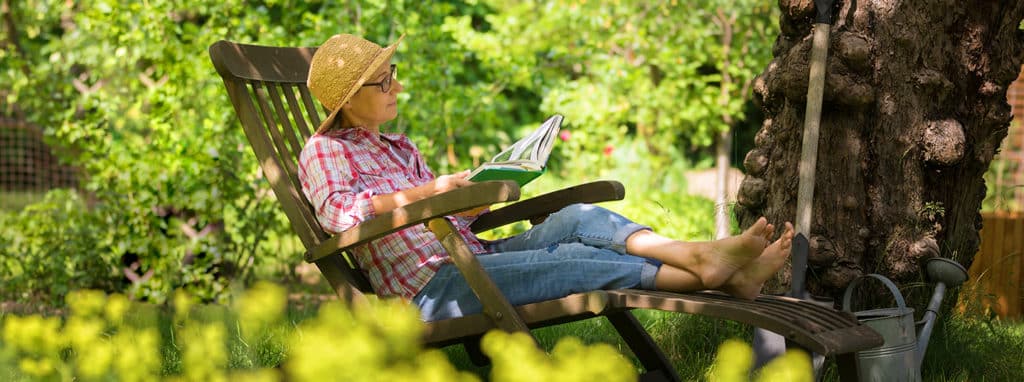
Physical Wellness
Getting out and moving is necessary for our physical health as well as mental. From lifting planters to digging and bending, gardening is a fun and rewarding physical activity. Even if it doesn’t raise your heartbeat like more conventional workouts, you’re still burning far more calories that sitting indoors or in front of a screen.
Vertical gardening allows you to use more surfaces to grow, from walls, fences, and exterior barriers. There is no limit to what you can grow, from vegetables, berries, perennials and more.
Not only are vertical gardens budget-friendly, they can get your creative juices flowing. You can decorate whatever outdoor space you have, from backyard to balcony.
Even if you are just foraying into the fabulous world of vertical gardening, there are plenty of easy projects to get you started.

Whether you are an urban-dweller living in a smaller space or you’re just plant-head with plenty of pots, vertical gardening is an appealing choice for a number of reasons:
• Don’t use up much space nor do they require it
• They are fairly low-maintenance
• Improve health and wellness
• May act as a living wall or natural
• They are attractive and affordable

As people we are genetically-programmed to spend time outside; however demands of our modern lives do not always make this possible. The tranquility of being surrounded by gardens shows to chemically reduce stress levels – simply spend time outdoors and you feel peace and calm. Keeping your mind focused and hands occupied with gardening puts you in a headspace that allows you to forget your worries. The act of planting is a hopeful one, as you grow new life, beautiful surroundings, and build a future from the soil.

climbing vines
Greens that climb and sprawl like ivy are great for covering less attractive walls or can also increase privacy. Other popular and pretty climbers are clematis, honeysuckle, and jasmine (not to mention pleasingly fragrant, too.)

hanging or wall planters
Using hooks, a pergola or a ceiling of terrace, hanging planters will allow plants to grow and sprawl vertically. Other ideas include wall planters or the ever-popular hanging baskets. For an eco- and budget-conscious vertical garden idea, use plastic bottles filled with flora and hung. Or DIY a trellis with cut wire.
Are you a lover of luscious greenery? You are not alone, considering the indoor jungle garden trend is sprawling over social media. Interior designers are also splashing green in rooms, and we don’t just mean paint.
Besides the obvious aesthetic appeal, plants are proven to help our health, from air purification, lowering stress levels, and overall wellness.
Here are our expert tips to transform your home into an indoor jungle that will make Tarzan and Jane green with envy.
let there be light
Look at what type of natural light you have coming in through your windows. Indirect sunlight generally works best. Be realistic about choosing the types of plants that will thrive in whatever light conditions you have.

credit: www.jeanstofferdesign.com 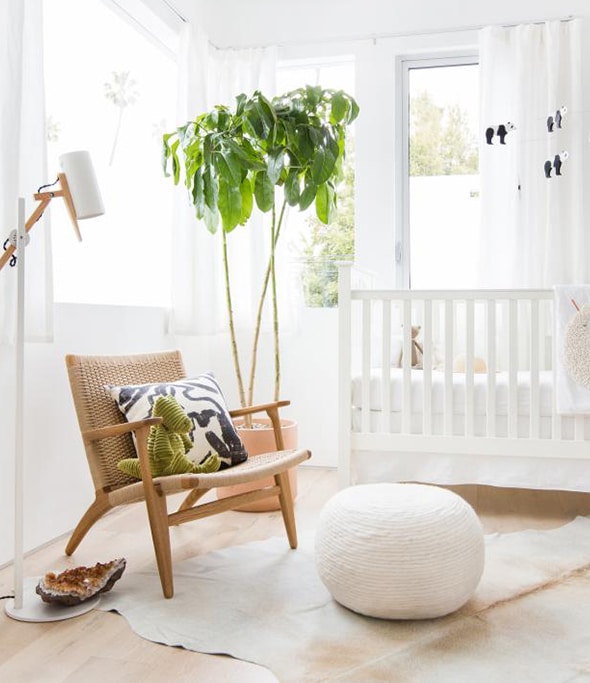
credit: www.tessaneustadt.com
group your greens
By grouping your plants together, especially ones of varying size, you will create eye-pleasing depth. Have fun experimenting with different heights and put them into tableaux on windowsills, shelves, tables and plant stands. Social media has really given rise to suspended hanging planters as well, a beautiful way to add interest and depth.
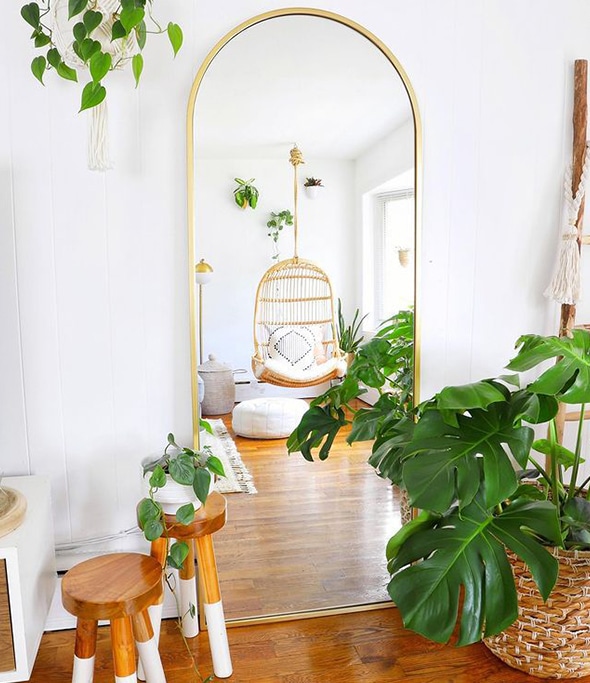
credit: www.instagram.com/modernhousevibes 
credit: www.instagram.com/hiltoncarter
make a shelfie
If video conferencing has taught us anything, it is the importance of beautiful backgrounds, and real-life is always nicer than virtual backgrounds. Group plants on your shelves, both trailing vines and small shelf-sitters for visual appeal. Install shelving if you don’t have it already, and populate them with plants that grow vertically as well as spread out horizontally.

credit: www.instagram.com/saskiatabea 
credit: www.instagram.com/thistle.harvest 
credit: www.loveandrenovations.com
statement pieces
As most interior designers will agree, nothing makes a statement like a large and dramatic tropical plant. Add one to a large pot and place in a corner of the room to add lushness and life. Photogenic and fast-growing ones include palms, birds of paradise or monstera.
As houseplant owners will have noticed, even indoor plants are affected by seasons. Spring is when indoor plants come out of dormancy, marking the start of their active growing season. Longer days and warmer temperatures make spring one of the most vital times to grow indoor plants.
These changes sometimes present challenges. Here’s our list of top tricks and tips to help make the seasonal transition easier on your green babies and set them up for a bright, bountiful future.

step 1. spring clean greens
That’s right, spring cleaning isn’t just for your house, it’s important for your houseplants, too. Gently clean leaves with a duster or damp cloth. If they are sturdy enough, pop them in the shower with the water gently running. If you like shiny leaves, skip waxes and use a mild, chemical free dish soap.
step 2. got to repot
Spring is the optimal time to repot, giving plants more space to flourish. Repotting plants allows them to expand and promotes fresh growth. How to tell if a plant needs repotting? Check for:
• Roots growing out the bottom of the pot or top of the soil
• The pot physically appears to be expanding
• Water leaks right through the soil without absorbing the water

step 3. slowly introduce them to the outdoors
Some indoor plants love spending summer outside but to avoid shocking them, gently transition plants by bringing them out only for a few hours. Gradually increase the time so they adapt to being outdoors, as long as they are not left out at night unless temperatures are consistently mild. Bear in mind, plants can get sunburnt so avoid direct summer sunlight. Drainage holes are a must to prevent drowning from heavy rainfalls.

step 4. adjust watering and feeding
Plants require more water in spring and summer. Start your adjustments when spring arrives and feed them with nutrient rich soil or introduce plant food. Rather than following a watering schedule, test the dampness of the soil, observe how your plant is reacting to sun and water, and follow its lead.

step five. prune
As you know, although trimming off leaves and branches might seem counterintuitive to allowing plants to grow big, pruning any unhealthy or dried out parts will stimulate new growth.
step 6. bring the outside, in
Rainwater is more nourishing for plants than tap water, so collect some on the next rainfall to water your houseplants that remain inside. Place them by open windows when warm enough to give them fresh air and humidity.


step 7. window on, window off
During wintertime you may have relocated a plant from a chilly window, in spring you may wish to get it back. Just be conscious that sunlight can still dry out or burn delicate plants, so opt for indirect light near a window. Being the conscious plant parent you are, you’ll figure out what conditions work best.
As any chef or amateur cook knows, fresh herbs make a dish come alive. Some like natural herbs for homeopathic and aromatherapy purposes. Whatever your use for them, you can always have fresh herbs handy.


step 1. spring clean greens
That’s right, spring cleaning isn’t just for your house, it’s important for your houseplants, too. Gently clean leaves with a duster or damp cloth. If they are sturdy enough, pop them in the shower with the water gently running. If you like shiny leaves, skip waxes and use a mild, chemical free dish soap.

step 4. adjust watering and feeding
Plants require more water in spring and summer. Start your adjustments when spring arrives and feed them with nutrient rich soil or introduce plant food. Rather than following a watering schedule, test the dampness of the soil, observe how your plant is reacting to sun and water, and follow its lead.
terrariums are terrific
From cooking splatters to being playful cats, fresh herbs can be prone to damage. Not only are terrariums pretty and on-trend, but they also do a great job at protecting dainty herbs.
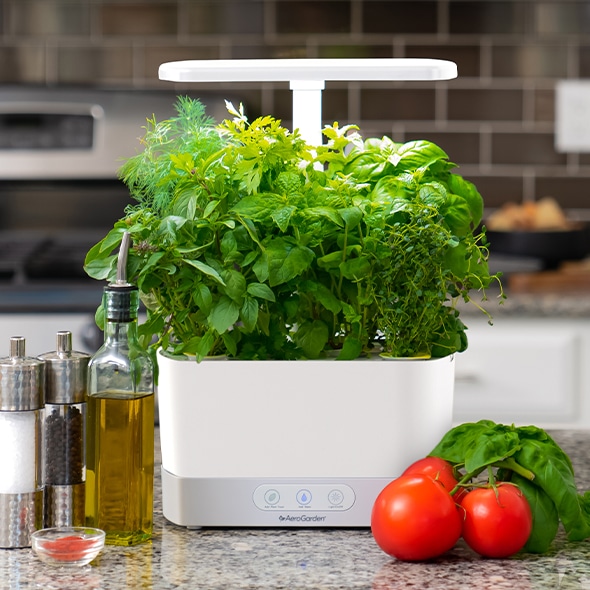
hydroponics
Also known as aero gardening, hydroponic gardening is a tried-and-true method to grow fresh food indoors. Hydroponics will do everything for you except the fun parts – trimming and eating, which you get to do.
companionship
Living things need companionship, and like people, plants are the same! Some herbs thrive better when planted next to certain ones. We have some examples below but a little research will uncover many more pairings. For example, basil and parsley require more water than rosemary and sage. Plant mint by itself as it tends to grow fast and furiously.
